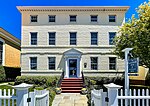Perry Mill
Buildings and structures in Newport, Rhode IslandCotton mills in the United StatesHistoric American Buildings Survey in Rhode IslandIndustrial buildings and structures on the National Register of Historic Places in Rhode IslandIndustrial buildings completed in 1835 ... and 3 more
NRHP infobox with nocatNational Register of Historic Places in Newport, Rhode IslandNewport County, Rhode Island Registered Historic Place stubs

The Perry Mill is a historic mill building at 337 Thames Street in Newport, Rhode Island. It is a large five-story stone structure on the Newport waterfront. It was built in 1835 by master stonemason Alexander MacGregor (who also oversaw the construction of Fort Adams in Newport) as part of an initiative to boost the city's flagging economy. Of the four mills built in the 1830s only this one and the Newport Steam Factory survive. This building was originally four stories when built.It was added to the National Register of Historic Places in 1972. The building now houses a club and hotel.
Excerpt from the Wikipedia article Perry Mill (License: CC BY-SA 3.0, Authors, Images).Perry Mill
Christie's Landing, Newport
Geographical coordinates (GPS) Address Nearby Places Show on map
Geographical coordinates (GPS)
| Latitude | Longitude |
|---|---|
| N 41.483888888889 ° | E -71.315277777778 ° |
Address
Christie's Landing
02840 Newport
Rhode Island, United States
Open on Google Maps








